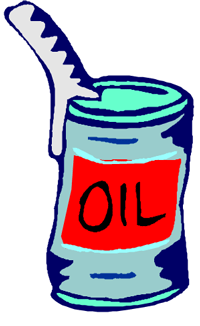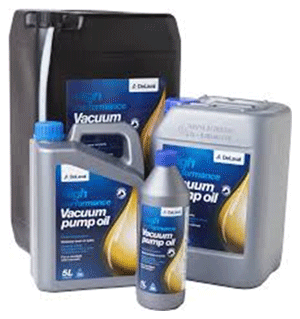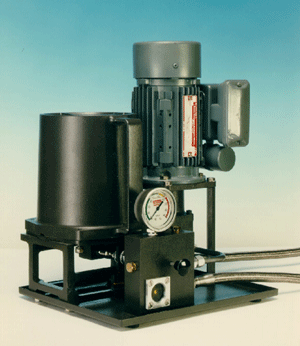In the world of mechanical oil sealed rotary vacuum pumps there is a need for a variety of oils and fluids to suit the specific type of pump, its duty and the process it is used on. This discussion covers high vacuum pumps only, such as are used in the heat treating and vacuum furnace industry. These same vacuum pumps are used in many other industrial and scientific applications and have to work under many different types of conditions including one that many people expose their pumps too – neglect!
Rotary vane vacuum pumps are available as direct drive (usually 1800 rpm) and vee belt drive (between 400 and 500 rpm) versions. Rotary piston vacuum pumps are generally vee belt driven and run at about 500 rpm.
The work duty of a vacuum pump can vary between intermittent use and running continuously. They can also be used for cyclic duty, to evacuate a loadlock for example, where the pump evacuates a chamber from atmosphere to vacuum every few minutes. The vacuum process can also vary, from clean air pumping to hazardous gas, wet vapor pumping and dirty/dusty atmospheres.
All these factors need to be taken into consideration in case the duty or process doesn’t suit the manufacturer’s standard oil or requires accessories to cope with the contaminants being pumped.
 |
| Fig. 1. Oil is oil, right? NOT |
What are the functions and requirements of Vacuum Pump Oil?
We generally think of lubrication as the main use for oil. In vacuum pumps the functions of the oil are:
- Sealing
- Lubrication
- Cooling
- Corrosion protection
- Flushing contaminants
- Noise reduction
Oils for rotary vacuum pumps have low vapor pressures, in the range of 10-4 Torr at room temperature. They are mineral oils that are refined until the required vapor pressure is attained. They must also have a sufficiently low vapor pressure at the normal operating temperature of the pump as this determines the lowest pressure that the pump can attain.
When a vacuum pump is first started you may notice that the indicated vacuum is lower than that seen when the pump has warmed up. Cold or cool oil will have a lower vapor pressure and allow the vacuum to create a lower pressure. The vapor pressure will rise as the fluid gets hotter and the pump will not reach quite as low a pressure.
Remember that the “ultimate vacuum” stated by the pump manufacturer in a pump manual is measured with a calibrated vacuum gauge when the pump is new and using perfectly clean and fully degassed vacuum pump oil. It is measured at the inlet to the pump. The vacuum level that you will measure in real work conditions will generally not be as low a pressure due to variables such as the oil condition, the position of the gauge head, the type of vacuum gauge used and the calibration of the gauge. The vacuum pump or pump set should be capable of producing a vacuum at least one decade or more below the required process vacuum.
The requirements for rotary pump oils are:
- Sufficiently low vapor pressure
- Correct viscosity
- Adequate lubrication properties
- Chemically suitable for the materials being pumped
- Chemically stable at pump working temperature, and
- Not hazardous to health
Paraffinic base mineral oils are suitable for the majority of vacuum pump applications in industry and science. Unlike motor oil that contains many additives, vacuum pump oil additives are limited to corrosion resistance, anti-oxidation and perhaps foaming.
For applications that may contain high percentages of oxygen, acids and hazardous gases there are alternative synthetic fluids available. As a development of the semiconductor industry (computer chips) where many hazardous, corrosive and pyrophoric gases are used vacuum pumps have been developed that have no lubricant at all in the pumping chamber areas of the pump. These are called dry pumps and are the subject of another discussion.
The typical oil used in a large rotary piston vacuum pump is a mineral oil that has been through a distillation process to reduce its vapor pressure. These vacuum pumps have an ultimate vacuum, sometimes called “blank off” vacuum, of 0.010 Torr (10 microns, 1 x 10-2 Torr or 0.0133 mbar). The oil has a viscosity similar to SAE 30 oil.
The SAE 30 viscosity vacuum pump oil is also used in smaller rotary vane design pumps driven by a vee belt drive from the motor. In the newer design direct drive vacuum pumps that run at around 1750 rpm, thinner SEA 20 vacuum pump oil is used. In some applications, where the vacuum pump may be colder than room temperature, there are SAE 10 oils available.
How often should I change the Vacuum Pump Oil?
 |
| Fig. 2. Vacuum pump oil |
Vacuum pump manufacturers will recommend when to change the oil in a pump, but it is usually meant only as a guide and for pumps running on a clean process. For example, the Edwards Stokes Microvac rotary piston pump manual recommends an oil change every 300 running hours. This is less than two weeks if the pump is running 24/7. For a clean process that time may be extended to about 500 hours with no harm to the pump. However, if the process is dirty and sends dust or vapors to the pump, the oil can become contaminated quickly and should be changed more frequently.
This means that it is up to you, the pump user, to establish guidelines for oil changes based on your process. If the pump oil becomes contaminated with condensed vapor the vacuum generated will soon deteriorate due to that liquid mixed with the oil. Often this is water, which has a vapor pressure of about 18 Torr at ambient temperature. That means this liquid will re-evaporate on the inlet (low pressure) side on the pump cycle and fill the pumping volume with vapor. Then the pump has little of no volume left to pump gas from the process and the process chamber pressure will rise.
If the contaminant is dust or powder from the process chamber it will mix with the oil and then cause mechanical wear in the bearings and and on any close fitting metal surfaces that have an oil film between them. You may have seen the effect of contamination by solids on the lower hinge bar of rotary piston pumps. What you may not see, because the oil circulates through the bearings and then to the interior of the pump, is wear and tear on the pump bearings.
Preventing contamination of vacuum pump oil.
There are several ways to prevent the oil from being contaminated, depending on the type of contamination, by using gas ballast, traps or filters.
If the amount of condensed vapor contamination is relatively low, opening the gas ballast valve will allow water vapor to be passed through the pump without condensing. The manufacturers specification usually shows the water handling capacity of a specific pump in grams/hour or ounces/ hour. If the amount of condensed vapor is above this limit some type of condenser or cold trap should be installed on the inlet side of the pump.
If the process is dusty, i.e. a solid contaminant, an inlet filter can be installed, designed to suit the type and amount of dust. Some filters have a cyclone design that causes the gas flow to circulate around the filter interior so that heavy solids drop to the bottom. The exit from that type of filter is from the top of the body where the gas flow should be cleanest. There are also filter elements available that will catch the solids, either a pleated style element for fine solids, or a wetted metal mesh element for high flow applications. Remember that filters will reduce the effective pumping speed and they also do need to be maintained regularly.
Another option if solid contaminants are getting into the oil is to install an external oil filter on the pump. This device takes the contaminated oil from the reservoir, passes it through the filter unit and then returns it to the oil piping before the oil reaches the bearings. That gives the bearings clean oil and will extend their life.
Remember to use the necessary PPE (personal protective equipment) when changing oil, and to dispose of any contaminated fluids in a safe manner.
Mineral oils and other vacuum pump fluids
Oil seems such a simple product until you do some research and find out how many different types of oil there are. Most lubricating oils are paraffinic based oils that are processed to create the best product for the application. The product is refined using solvent separation methods from paraffinic crude oil. (Other base oils are Naphthenic and Aromatic)
Singly distilled oil
Processing the base oil through a single distillation reduces the vapor pressure of the oil so that it is suitable for single stage oil sealed vacuum pumps. It also reduces the sulphur content of the oil, which is one of the first constituents to break down in high temperature conditions. This oil has a straw color.
Double distilled oil
Going through a second distillation reduces the vapor pressure and the sulphur content even more. This oil can be used on slightly more aggressive processes and is used in two stage vacuum pumps that create a lower pressure. This oil has a paler straw color due to the lower sulphur content.
Ultra Grade Oil
This oil is a fairly recent addition to the vacuum pump industry, and used mainly on small laboratory sized two stage pumps. When Edwards introduced the RV model vacuum pumps in the early 1980s the running temperature of the pump was higher than other pumps to help increase the water vapor handling capacity. The double distilled oils available at the time had a shorter life when operating at a higher temperature. I was slightly involved in the project to develop hydro-treated oils for vacuum pump use that had a higher temperature rating and improved chemical resistance. Hydro treating is an alternative process to solvent refining.
White or Technical White oil
This oil has even more processing than single and double distilled oils to reduce the sulphur content, to the point that it has very little color at all. It can be used on processes that have chemical contamination, such as LCMS instruments (liquid chromatography mass spectrometer), and has a longer life than less processed oils. It appears that oil called “45” oil may be similar, but is a semi-synthetic oil. This “45” oil has fixed peaks on a mass spectrometer analysis that allows the mass spec user to eliminate these peaks when analyzing samples. Regular oil from oil wells around the world has similar peaks but they are not as stable as for the semi-synthetic product.
Flushing oils
Flushing oils are sold by a number of companies to help clean pumps that become contaminated. They are typically used only during a vacuum pump service to soften and remove baked on contaminants. The oil contains a higher amount of solvent product and may have a higher vapor pressure than regular vacuum pump oil.
Inert fluids
 |
| Fig. 3. External oil filtration unit. |
When vacuum processes include high concentrations of oxygen or other hazardous gases or gas mixtures a hydrocarbon based pump fluid becomes a problem. It can either be a fire hazard in the case of high oxygen flows or be chemically attacked in the case of many semiconductor type processes.
Initially, in my career, the first application that I saw requiring pump fluid other than oil was in the gas cylinder filling industry. Gas cylinders are evacuated one or more times during the process to dilute and eliminate any remaining gas from them before they are refilled. Cylinders containing different gases may be processed on the same filling system so there is a chance that oxygen gas may enter the vacuum pump on the system. Consequently, the standard vacuum pump fluid used by most gas cylinder companies was a fire “retardant” phosphate ester fluid. This fluid was not completely inflammable.
Later, when the semiconductor industry was in its infancy (1980s) most gas cylinder filling companies changed to using completely inert (inflammable) vacuum pump fluids called perfluoropolyethers (PFPE).
The brand names for these inert fluids are Krytox and Fomblin. They were developed for the space industry (NASA et al.) but were found to have lubrication properties in addition to being completely inert to any chemical attack.
By the end of the 1980s these inert fluids were being used in all “wet pumps” (fluid lubricated) in the semiconductor industry. Since then “dry pumps” (no fluid in the pumping volume) have been designed and perfected, but inert fluids are still used to lubricate gears and bearings that are outside the vacuum envelope of the pump.
Where to buy Vacuum Pump oils and fluids
This is not a forum to advertise or promote specific suppliers, but let me say this. No vacuum pump manufacturer or vacuum pump industry distributor processes oils or fluids for its own use. There are three companies that I know of in the USA who probably or possibly process base oils for vacuum pump use, I have not seen their plants to show otherwise. All vacuum pump manufacturers have their own “name and/or grade” for oils that they warranty as a suitable product for their pumps. Most vacuum pump oils, with low vapor pressure, are refined by specialized oil companies that can process relatively low volumes of product. These companies can “private label” the vacuum pump fluids they process in any container size and with any name on it.
You may pay a premium to buy your vacuum pump oils from a vacuum pump manufacturer, but you are assured of the correct fluid. Other suppliers may offer a cross reference to their product, but be careful that it is an equivalent. Lastly, I suggest that you never buy “vacuum pump oil” without knowing that it is the correct oil for your pump and application.
Copyright Howard Tring, Tring Enterprises LLC Vacuum & Low-Pressure Consulting.
